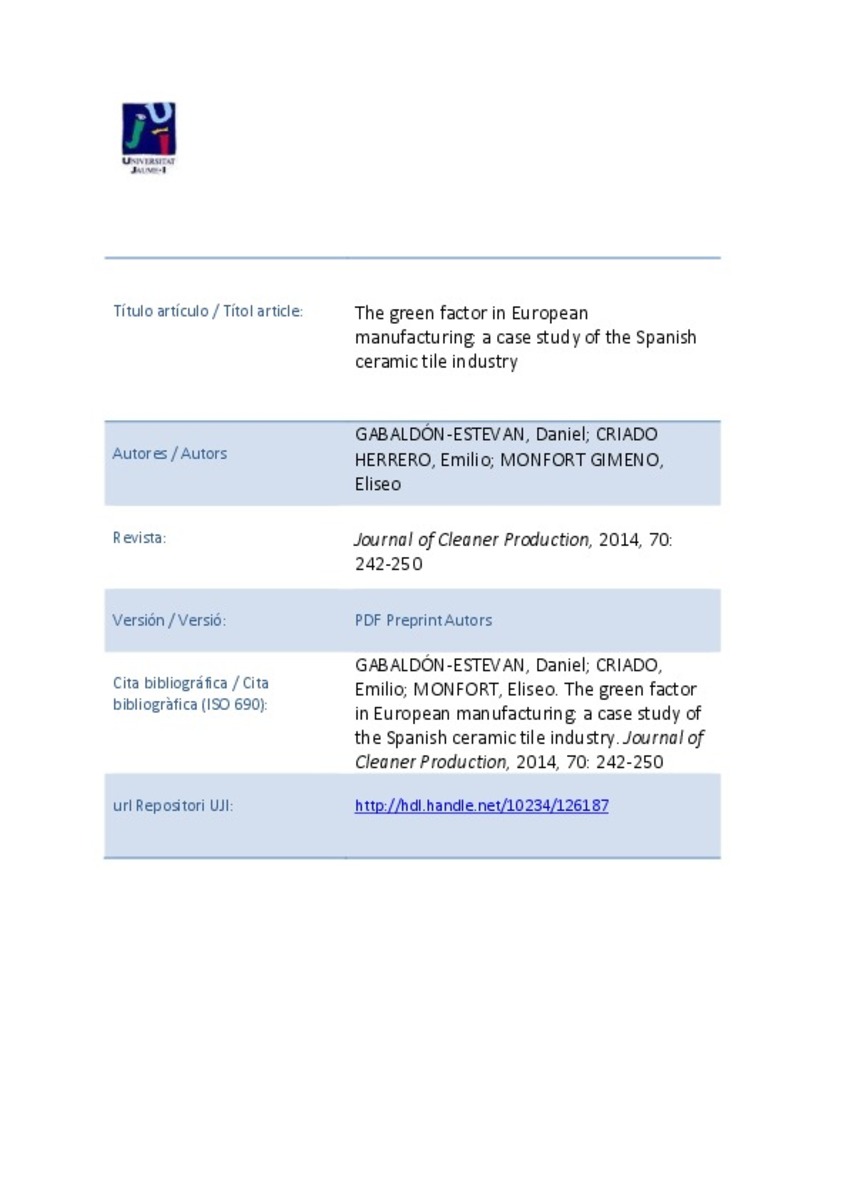Mostrar el registro sencillo del ítem
The green factor in European manufacturing: a case study of the Spanish ceramic tile industry
| dc.contributor.author | Gabaldón Estevan, Daniel | |
| dc.contributor.author | Criado Herrero, Emilio | |
| dc.contributor.author | Monfort, Eliseo | |
| dc.date.accessioned | 2015-07-03T10:21:08Z | |
| dc.date.available | 2015-07-03T10:21:08Z | |
| dc.date.issued | 2015-07-03 | |
| dc.identifier.issn | 0959-6526 | |
| dc.identifier.uri | http://hdl.handle.net/10234/126187 | |
| dc.description.abstract | This paper analyses how environmental issues have affected and are continuing to affect the evolution of European manufacturing industries based on the example of the Spanish Ceramic Tile Industry (SCTI).1 The Ceramic Tile Industry (CTI)2 in Europe became very competitive and innovative in the early 1990s, with the Italian and the Spanish sectors, which are cluster-based, becoming world leaders. However, since 2008, this leadership position is being eroded. We provide an in depth analysis of the SCTI focusing on the influence of new European environmental regulations. The CTI has a major impact on the environment and has been the focus of environmental regulations. We also consider the innovation system and socioeconomic effects of the industry. In order to analyse the relationship between the environmental issues and innovation the empirical part of the paper builds on research on SCTI, including the industry value chain, and the innovation system and how it functions. We take account of the views of industry experts on the SCTI innovation system, its environmental impact and the constraints on the sector. Current research at the local level suggests that the environmental impacts of the industry are outweighed by its huge contribution to socioeconomic wellbeing. The transition from national environmental legal frameworks towards EU-wide regulation has had a clear effect on both the strategic goals and the management of the industry and the new regulation combined with a more complex international economic scenario is jeopardizing European manufacturing industries. This applies especially to traditional industries. The case study demonstrates that the capacity of the SCTI to adapt to new scenarios will be vital for its future survival and success. | ca_CA |
| dc.format.extent | 30 p. | ca_CA |
| dc.format.mimetype | application/pdf | ca_CA |
| dc.language.iso | eng | ca_CA |
| dc.relation.isPartOf | Journal of Cleaner Production, 2014, 70: 242-250 | ca_CA |
| dc.rights | Copyright © 2014 Elsevier B.V. All rights reserved. | ca_CA |
| dc.rights.uri | http://rightsstatements.org/vocab/InC/1.0/ | * |
| dc.subject | Sustainability | ca_CA |
| dc.subject | Distritual innovation systems | ca_CA |
| dc.subject | Manufacturing industry | ca_CA |
| dc.subject | Ceramic tile industry | ca_CA |
| dc.subject | Environmental innovation | ca_CA |
| dc.subject | Innovation system | ca_CA |
| dc.title | The green factor in European manufacturing: a case study of the Spanish ceramic tile industry | ca_CA |
| dc.type | info:eu-repo/semantics/article | ca_CA |
| dc.identifier.doi | 10.1016/j.jclepro.2014.02.018 | |
| dc.rights.accessRights | info:eu-repo/semantics/openAccess | ca_CA |
| dc.relation.publisherVersion | http://www.sciencedirect.com/science/article/pii/S0959652614001620 | ca_CA |
| dc.edition | Pre-print | ca_CA |
| dc.type.version | info:eu-repo/semantics/submittedVersion |
Ficheros en el ítem
Este ítem aparece en la(s) siguiente(s) colección(ones)
-
QUI_Articles [296]







